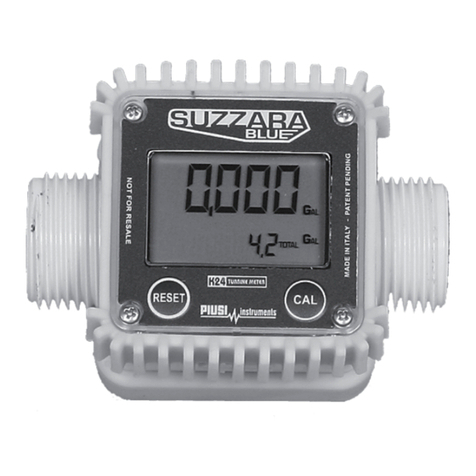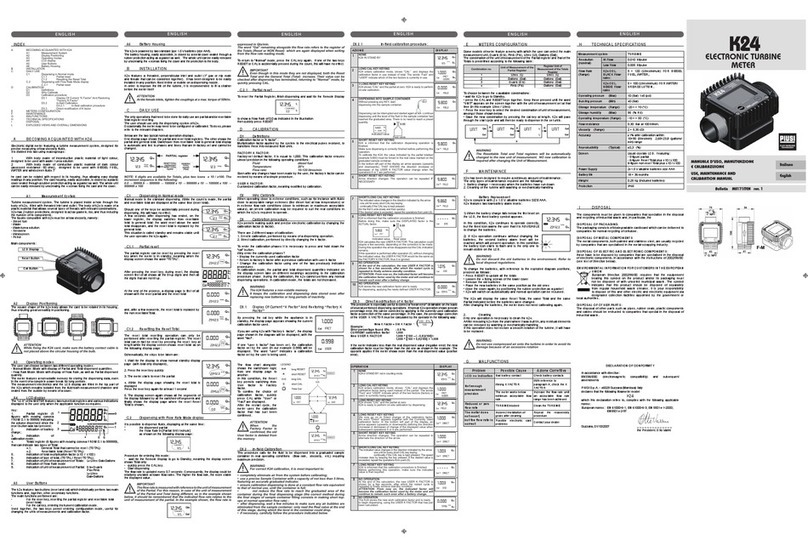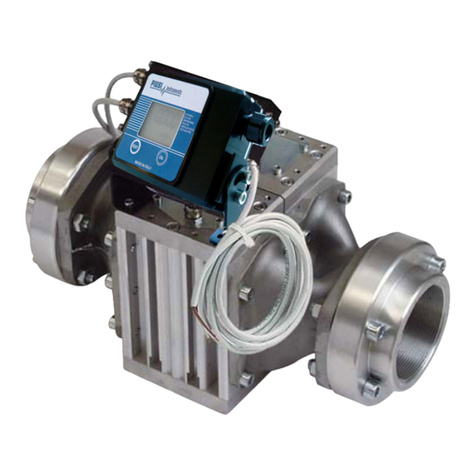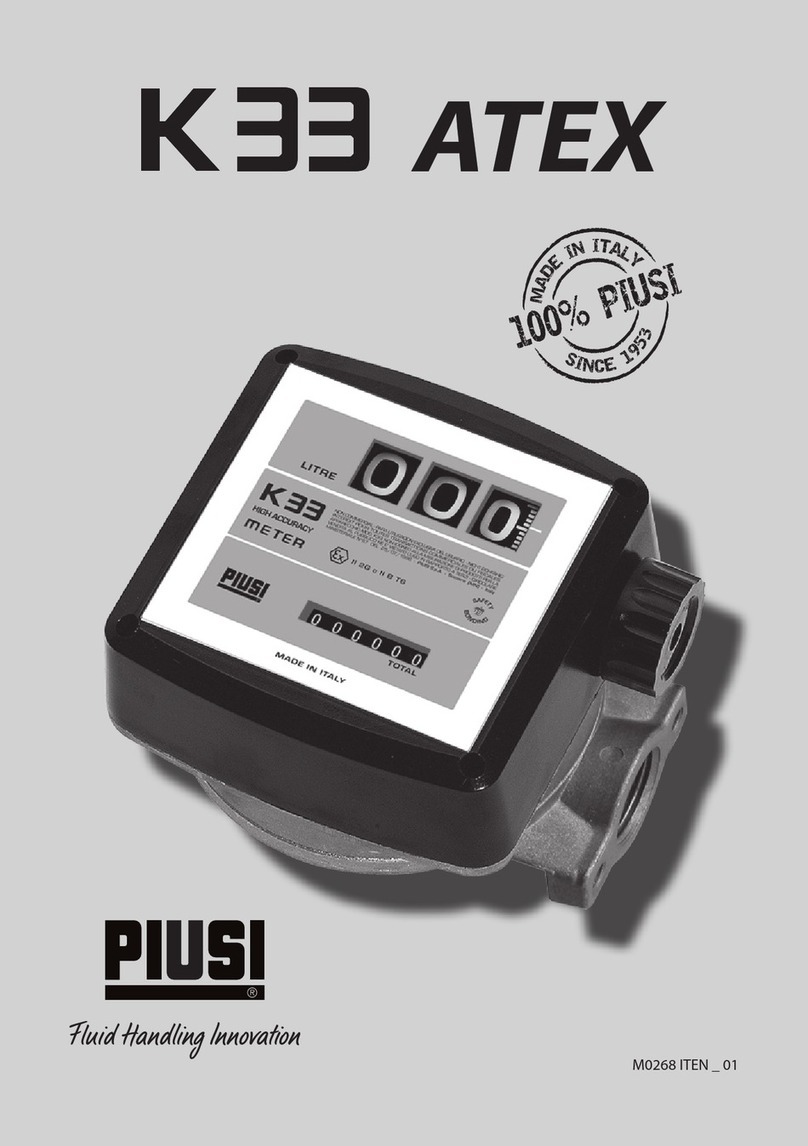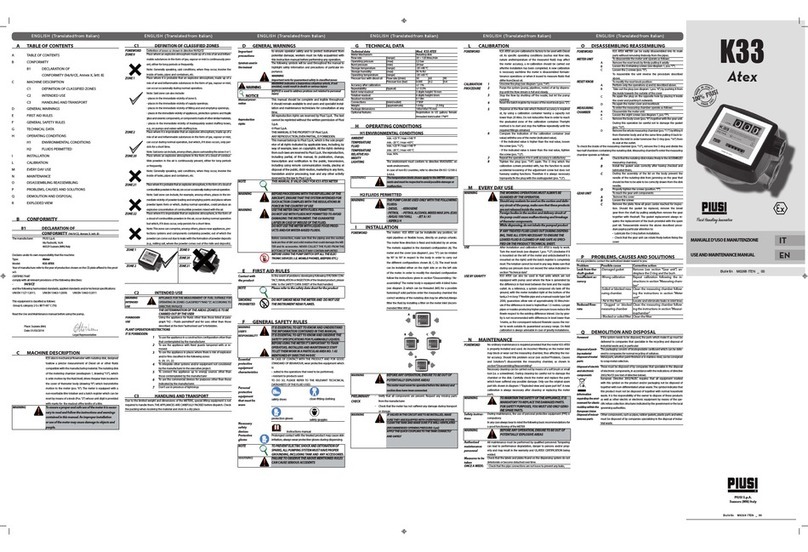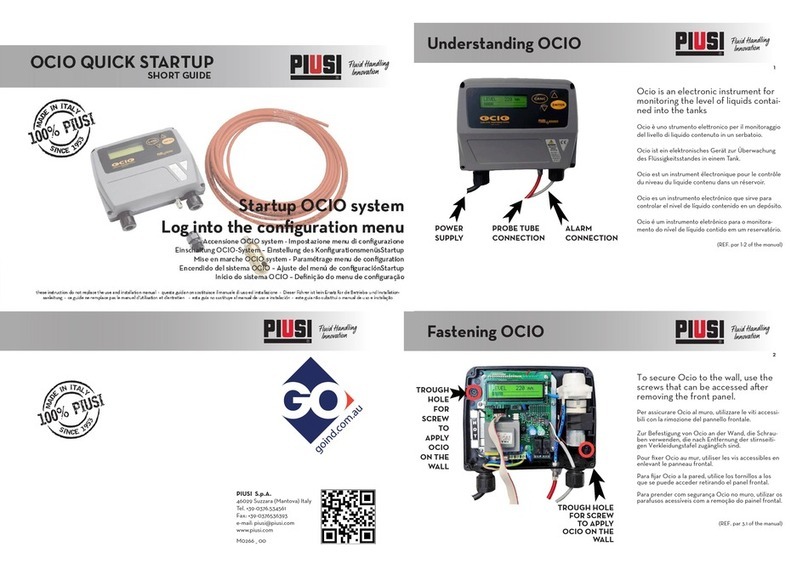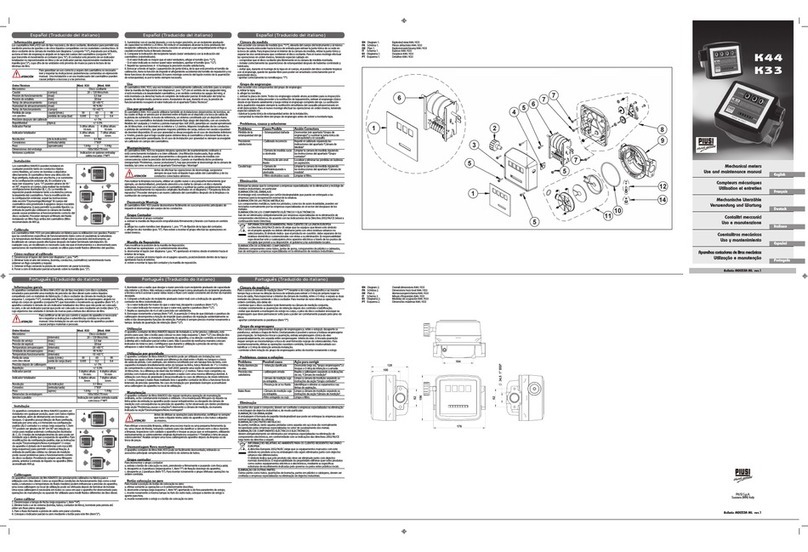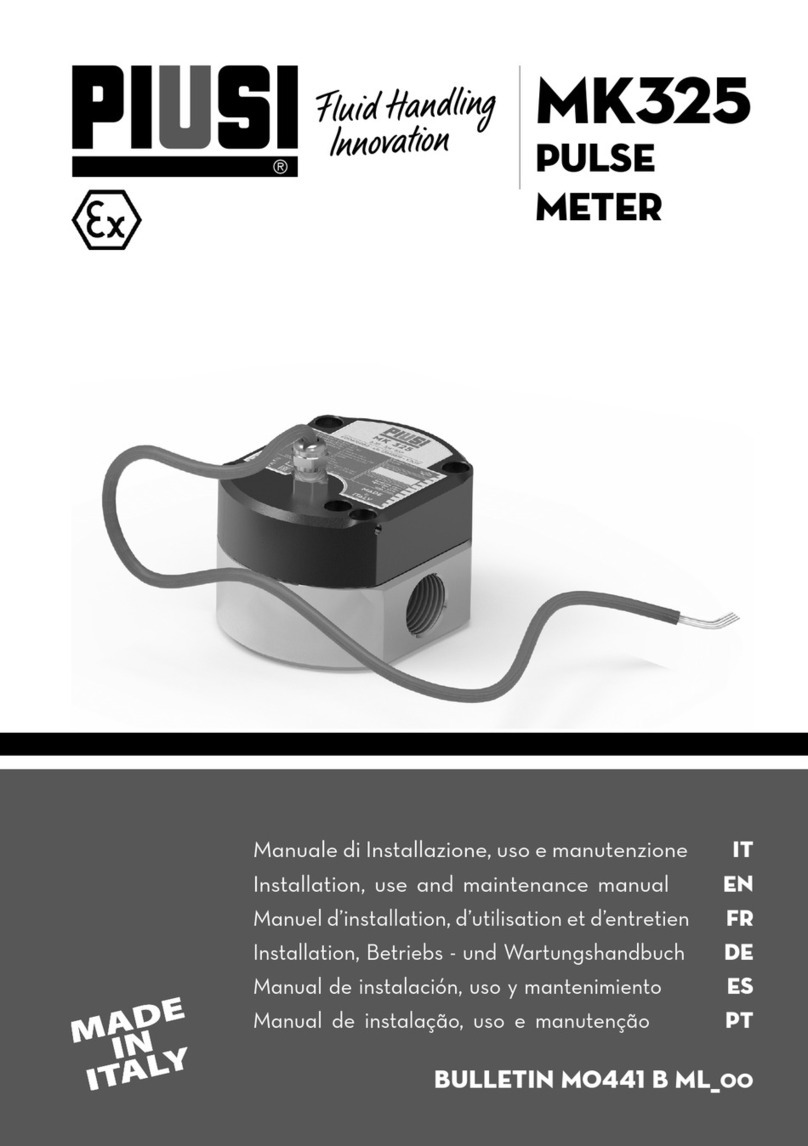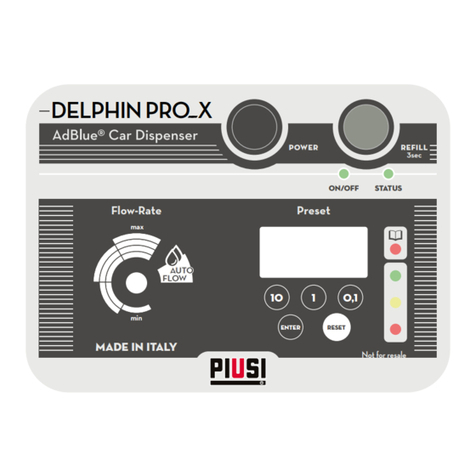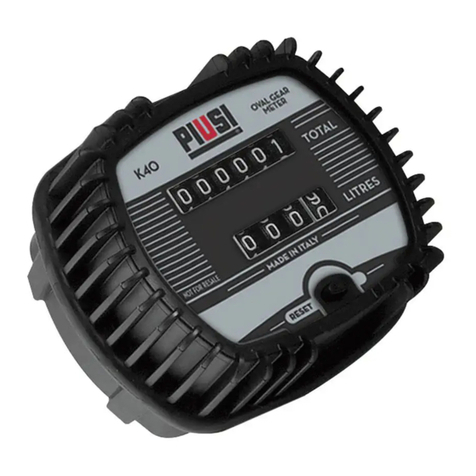ITALIANO ITALIANO ITALIANO ITALIANO ITALIANO ITALIANO ITALIANO
INDICE
A DICHIARAZIONE DI CONFORMITA’
B AVVERTENZE GENERALI
C ISTRUZIONI DI SICUREZZA
C.1 AVVERTENZE DI SICUREZZA
C.2 NORME DI PRONTO SOCCORSO
C.3 NORME GENERALI DI SICUREZZA
C.4 IMBALLO
C.5 CONTENUTO DELL’IMBALLO
D CONOSCERE K24
D.1 LIQUIDI COMPATIBILI
D.2 DISPLAY LCD
D.3 ORIENTAMENTO DISPLAY(SOLO VERSIONE METER)
D.4 PULSANTI UTENTE - LEGENDA
E MODALITÀ DI UTILIZZO
F INSTALLAZIONE
G USO GIORNALIERO
G.1 EROGAZIONE IN MODALITÀ NORMALE (NORMAL MODE)
G1.1 AZZERAMENTO DEL PARZIALE
G1.2 AZZERAMENTO DEL RESET TOTAL( TOTALE AZZERABILE)
G.2
EROGAZIONE CONVISUALIZZAZIONE PORTATAISTANTANEA(FLOW RATE MODE)
G.2.1 AZZERAMENTO DEL PARZIALE
H CALIBRAZIONE
H.1 DEFINIZIONI
H.2 MODALITÀ DI CALIBRAZIONE
H.2.1
VISUALIZZAZIONE“K FACTOR”ATTUALEE RIPRISTINO DEL “FACTORYK FACTOR”.
H.2.2 CALIBRAZIONE IN CAMPO
H.2.2.1
PROCEDURA PER EFFETTUARE LA CALIBRAZIONE IN CAMPO
H.2.3 MODIFICA DIRETTA DEL K FACTOR
I CONFIGURAZIONE DEI CONTALITRI
L MANUTENZIONE
M MALFUNZIONAMENTI
N SMALTIMENTO
O DATITECNICI
P VISTE ESPLOSE ED INGOMBRI
A DICHIARAZIONE DI CONFORMITA’
La sottoscritta: PIUSI S.p.A
Via Pacinotti c.m. z.i.Rangavino
46029 Suzzara - Mantova - Italia
DICHIARA
sotto la propria responsabilità, che l’apparecchiatura descritta in appresso:
Descrizione : Contalitri
Modello : K24
Matricola: riferirsi al Lot Number riportato sulla targa CE apposta sul prodotto
Anno di costruzione: riferirsi all’anno di produzione riportato sulla targa CE apposta sul prodotto.
è conforme alle disposizioni legislative che traspongono le direttive :
- Direttiva Compatibilità Elettromagnetica 2004/108/CE
La documentazione è a disposizione dell’autorità competente su motivata richiesta pres-
La persona autorizzata a costituire il fascicolo tecnico e a redigere la dichiarazione è Otto
Varini in qualità di legale rappresentante.
Suzzara, 01/01/2010 Otto Varini
legale rappresentante
B AVVERTENZE GENERALI
Avvertenze
importanti Per salvaguardare l’incolumità degli operatori, per evitare possibili
danneggiamenti e prima di compiere qualsiasi operazione, è indispen-
sabile aver preso conoscenza di tutto il manuale istruzioni.
Simbologia
utilizzata nel
manuale
Sul manuale verranno utilizzati i seguenti simboli per evidenzia-
re indicazioni ed avvertenze particolarmente importanti:
ATTENZIONE
Questo simbolo indica norme antinfortunistiche per gli
operatori e/o eventuali persone esposte.
AVVERTENZA
Questo simbolo indica che esiste la possibilità di arreca-
re danno alle apparecchiature e/o ai loro componenti.
NOTA
Questo simbolo segnala informazioni utili.
Conservazio-
ne del ma-
nuale
Il presente manuale deve essere integro e leggibile in ogni
sua parte, l’utente nale ed i tecnici specializzati autorizzati
all’installazione e alla manutenzione, devono averela possi-
bilità di consultarlo in ogni momento.
Diritti di ripro-
duzione Tutti i diritti di riproduzione di questo manuale sono riservati
alla Piusi S.p.A.
Il testo non può essere usato in altri stampati senza autoriz-
zazione scritta della © Piusi S.p.A.
IL PRESENTE MANUALE È PROPRIETÀDELLA PIUSI S.p.A.
OGNI RIPRODUZIONE ANCHE PARZIALEE’ VIETATA.
C ISTRUZIONI DI SICUREZZA
C.1 AVVERTENZE DI SICUREZZA
ATTENZIONE
Rete elettrica
- veriche pre-
liminari all’in-
stallazione
Evitare assolutamente il contatto tra l’alimentazione
elettrica e il liquido da pompare.
Interventi di
controllo ma-
nutenzione
Prima di qualsiasi intervento di controllo o manutenzione,
togliere L’ALIMENTAZIONE5
Ai ni della
sicurezza,
rispettare gli
avvisi e le av-
vertenze sotto
specicati pri-
ma di mettere
in funzione il
contalitri.
In caso di utilizzo di liquidi inammabili, osservare le precau-
zioni contro i rischi di incendio o di esplosione
In caso di travaso di liquidi pericolosi, seguire sempre le pre-
cauzioni di sicurezza del produttore del liquido
Smaltire sempre i solventi utilizzati per la pulizia in modo
sicuro, secondo le istruzioni del produttore del solvente.
Durante la rimozione del contalitri, può vericarsi la fuoriusci-
ta di liquido. Seguire le precauzioni di sicurezza del produtto-
re del liquido per la pulizia di piccole fuoriuscite
Non soare aria compressa attraverso il contalitri
Evitare che i liquidi si secchino all'interno del contalitri
C.2 NORME DI PRONTO SOCCORSO
Contatto con il
prodotto
Per problematiche derivanti dal prodotto trattatocon OCCHI, PELLE, INALAZIONE
e INGESTIONE fare riferimento alla SCHEDA DI SICUREZZA del liquido trattato.
NOTA Per informazioni speciche, fare riferimento alle schede di
sicurezza del prodotto
NON FUMARE Durante l’operazione di erogazione, non fumare e non usare
amme libere.
ATTENZIONE Durante la misurazione di liquidi inammabili, adotta-
re precauzioni di prevenzione incendi ed esplosioni
Durante l’impiego di liquidi pericolosi, seguire le note
di sicurezza e prevenzione, presenti sulla scheda di
sicurezza del liquido trattato.
Non immergere il meter.
C.3 NORME GENERALI DI SICUREZZA
Caratteristiche essen-
ziali dell’equipaggia-
mento di protezione
Indossare un equipaggiamento di protezione che sia idoneo
alle operazioni da eettuare; resistente ai prodotti impiegati
per la pulizia.
Dispositivi di
protezione
individuale da
indossare
Durante le fasi di movimentazione ed installazione, indossare
i seguenti dispositivi di protezione individuale:
scarpe antinfortunistiche;
indumenti attillati al corpo;
guanti di protezione;
occhiali di sicurezza;
Dispositivi di
protezione manuale di istruzioni
AVVERTENZA
In caso di travaso di liquidi pericolosi, seguire sempre le
Precauzioni di Sicurezza del Produttore del Liquido In-
dossare indumenti di protezione, come occhiali, guanti e
mascherina come da istruzioni.
In caso di utilizzo di liquidi inammabili, osservare le
precauzioni contro i rischi di incendio o di esplosione
Non misurare liquidi in presenza di fonti di accensione,
inclusi motori in funzionamento o caldi, sigarette ac-
cese, o riscaldatori elettrici o a gas
C.4 IMBALLO
Premessa K24 è fornito in scatola, con etichetta su cui compaiono i
seguenti dati:
1 - contenuto della
confezione
2 - peso del contenuto
3 - descrizione del
prodotto
C5 CONTENUTO DELL’IMBALLO
PREMESSA Per aprire l’imballo, utilizzare delle forbici o un taglierino.
NOTA Nel caso in cui uno o più componenti di seguito descritti
non siano presenti all’interno della confezione, contat-
tare il servizio di assistenza tecnica Piusi S.p.A.
ATTENZIONE Verificareche idatidi targacorrispondanoa quellideside-
rati. Perqualsiasi anomalia, contattareimmediatamente il
fornitore,segnalandola naturadeidifetti e,incaso didub-
biosullasicurezza dell’apparecchiatura,non utilizzarla.
D CONOSCERE K24
PREMESSA
Contalitri elettronico digitale provvisto di un sistema di misura a turbina,
progettato per una precisa misurazione di uidi a bassa viscosita’.
K24 è un meter bi-direzionale con display LCD e pulsanti di calibrazione concorpo
in alluminio (conduttivo) e progettato per le alte portate (120l/min - 32 GPM).
K24 è disponibile in 3 varianti:
1 a
METER - con display LCD e pulsanti di calibrazione(targaSILVER)
b
METER - con display LCD e pulsanti di calibrazione(targa ROSSA)
2PULSER - ad impulso monocanale, collegabile con un Meter.
D1 LIQUIDI COMPATIBILI
Sistema di
misura a
turbina
La turbina è posizionata all’interno di un foro che attraversail corpo del
K24 e dotato di ingresso ed uscita lettati M-F. I liquidi compatibili con
il K24 SONO A bassa viscosità e precisamente i seguenti:
Gasolio
Kerosene
Benzina
Benzina con alcool al 15% max
ATTENZIONE NON UTILIZZARE MAI CON LIQUIDI DIVERSI DAQUELLI
INDICATI.
Componenti Principali K24 METER Componenti Principali K24 Pulser
1Display LCD 1targhetta con dati tecnici
2Tasto RESET
3Tasto CAL
4Targhetta dati tecnici
3
21
4
1
D2 DISPLAY LCD (SOLO VERSIONE METER)
Premessa L’«LCD» del contalitri è provvisto di due registri numerici e di diverse
indicazioni che vengono visualizzate dall’utente solamente se la fun-
zione del momento lo richiede
1
Registro del parziale (5 cifre a virgola
mobile da 0.1 A 99999), che indica il
volume erogato dall’ultima volta che
è stato premuto il pulsante di reset
6Indicazione del tipo di totale, (total /
reset total)
2
Indicazione dello stato di carica delle
batterie
7Indicazione dell’unità di misura dei
totali: l=litri gal=galloni
3
Indicazione della modalità di calibra-
zione
8Indicazione della modalità “Portata
Istantanea”(Flow Rate)
4Registro dei totali (6 cifre a virgola
mobile da 0,1 a 999999), che può indi-
care due tipi di totale:
4.1. Totale generale non azzerabile (total)
4.2. Totaleazzerabile (reset total)
9
Indicazione dell’unità di misura del parzia-
le
: qts=quarti; pts=pinte;
l=litri; gal=galloni
5Indicazione del fattore di moltiplica-
zione dei totali (x10 / x100)
456
9
7
1
2
3
8
D3 ORIENTAMENTO DISPLAY (SOLO VERSIONE METER)
Premessa La forma quadrata del corpo K24, permette di ruotare la scheda nella
sua sede garantendo cosi’grande versatilita’ di orientamento.
Questo consente una facile lettura del display in tutte le posizioni.
La sede della scheda, è chiusa da un coperchio in plastica con
tenuta garantita dalla protezione in gomma che è anche guarni-
zione. Il tutto e’facilmente rimuovibile svitando le 4 viti che ssano
coperchio e scheda (1).
ATTENZIONE In fase di ssaggio scheda del K24, è importante fare
attenzione che il cavo del contatto pile non si posizioni
sopra la sede circolare dell’ampolla.
D4 PULSANTI UTENTE - LEGENDA
PREMESSA
K24 è dotato di due pulsanti (RESET e CAL) che svolgono, singolarmen-
te, due funzioni principali e, in combinazione, altre funzioni secondarie.
FUNZIONI
PRINCIPALI
- Per il tasto RESET, l’azzeramento del registro del parziale e di quello
del totale azzerabile (reset total)
- Per il tasto cal, l’entrata nella modalità di calibrazione dello strumento
FUNZIONI SE-
CONDARIE Utilizzati in combinazione, i due tasti consentono di entrarein mo-
dalità di congurazione (conguration mode), utile per modiche
sull’unita’di misura e sul fattore di calibrazione.
LEGENDA CALIBRARE,SIGNIFICAOPERAREAZIONI SUITASTI DELCONTA-
LITRI. DI SEGUITO, LA LEGENDA RELATIVA ALLASIMBOLOGIA
UTILIZZATA PERDESCRIVERELE AZIONI DAESEGUIRE
PRES
SIONE
BREVE
DEL
TASTO
CAL
CAL
PRES
SIONE
PRO
LUN
GATA
DEL
TASTO
CAL
CALCAL
CAL
PRESSIO
NE
BREVE
DEL
TASTO
RESET
RESET
PRES
SIONE
PRO
LUN
GATA
DEL
TASTO
RESET
RESET
RESET
RESET
E MODALITÀ DI UTILIZZO
MODALITA’ DI
UTILIZZO L’utente può scegliere tra due modalità diverse di utilizzo:
Il contalitri è provvisto di una memoria non volatile che permette di
mantenere i dati archiviati delle erogazioni eseguite anche in caso di
completa assenza di alimentazione per lunghi periodi
1 - Normal
Mode modalità con visualizzazione delle quantità parziali e totali erogate
2 - Flow rate
Mode modalità con visualizzazione della portata istantanea (ow rate), oltre
che del parziale erogato
F INSTALLAZIONE
Premessa K24 ha ingresso e uscita lettati (1”NPT o BSP maschio e femmina) in
asse. E’studiato per essere facilmente installato in qualsiasi posizione:
sso su una linea o mobile su una pistola di erogazione.
Prevedere sempre la presenza di un disco ltrante a monte dell’im-
pianto, al ne di garantire maggiore durata della turbina
ATTENZIONE NELLE INSTALLAZIONI SU IMPIANTO, POSIZIONAREK24
IN UN PUNTOCHE CONSENTA FACILE ACCESSOALLA SEDE
BATTERIE.
Collegamenti Per proteggere contro le perdite, assicurarsi che tutti i
letti siano chiusi con due o tre giri di nastro o compo-
sto sigillante compatibili con il liquido misurato
ATTENZIONE Assicuratevi che il nastro o compostosigillante non
interferisca con il usso
Assicurarsi che non vi siano perdite nei collegamenti.
Per sigillare le perdite, smontare e controllare il contali-
tri e sostituire il nastro o composto sigillante. Consulta-
re la sezione Risoluzione dei problemi
G USO GIORNALIERO
Premessa Le uniche operazioni che vengono compiute nell’utilizzo giornaliero
sono gli azzeramenti dei registri del parziale e/o del totale resettabi-
le. Puo’occasionalmente essere necessario congurare o calibrare il
contalitri. A tal proposito, fare riferimento ai capitoli specici.
Vengono di seguito riportate le due visualizzazioni tipiche del funzionamento normale.
In una schermata è visibile il registro del parziale e quello del totale azzerabile (reset
total). Nell’altra viene mostrato il parziale ed il totale generale. Il passaggio tra la visua-
lizzazione del totale resettabile e del totale generale è automatica ed è legata a fasi e
temporizzazioni impostate in fabbrica e non modicabili
NOTA I digit disponibili per i totali sono 6 a cui si aggiungo-
no due icone x 10 / x100.La sequenza di incremento
è la seguente: 0.0 -> 99999.9 -> 999999 -> 100000 X
10 -> 999999 x 10 -> 100000 x 100 -> 999999 x 100
G1 EROGAZIONE IN MODALITÀ NORMALE (NORMAL MODE)
Premessa Normal mode è l’erogazionestandard. Durante il conteggio, vengo-
no visualizzati contemporaneamente il“parziale erogato”ed il “totale
azzerabile”(reset total).
AVVERTENZA Premere accidentalmentei tasti durante l’erogazio-
ne, non comporta alcun eetto
STAND BY
Ad alcuni secondi dal termine dell’erogazione, sul registro inferiore la visua-
lizzazione passa dal“ totaleazzerabile” al ”totale generale”:
la scritta reset posta sopra alla scritta total scompare, ed il valore del“totale
azzerabile”, viene sostituito dal“totale generale”.
Questa situazione viene denita di riposo (o STAND-BY) e rimane stabile
no a quando l’utente non eettua altre operazioni.
G1.1 AZZERAMENTO DEL PARZIALE
Il Registro del Parziale può essere azzerato premendo il tasto
RESET quando il contalitri è in Stand-by, ovvero quando il di-
splay visualizza la scritta «TOTAL».
Dopo la pressione del tasto RESET, durante la fase di azzera-
mento, il display mostra in successione prima tutti i digit acce-
si, poi tutti i digit spenti.
Alla ne del processo viene mostrata dapprima una schermata
che presenta il Parziale azzerato e il ResetTotal
e, dopo alcuni istanti, il Reset Total viene sostituito dal Totale
NON azzerabile (Total)
G1.2 AZZERAMENTO DEL RESET TOTAL (TOTALE AZZERABILE)
VALIDO SOLOPER VERSIONE METER CON TARGA SILVER
L’operazione di azzeramento del ResetTotal è eettuabile
solo successivamente ad una operazione di azzeramento del
registro del Parziale. Infatti il ResetTotal può essere azzerato
premendo a lungo il tasto RESET mentre il display visualizza la
scritta RESET TOTAL come nella schermata seguente:
Schematicamente i passi da seguire sono:
1Attendere che il display sia nella schermata normale di
stand-by (con il solo Total visualizzato)
2Premere brevemente il tasto RESET
3Il contalitri inizia le sue fasi di azzeramento del Parziale
4
Mentre è visualizzata la schermata che indica il Reset Total
Premere nuovamente il tasto Reset per un tempo di almeno
1 secondo
5Il display torna nuovamente a mostrare tutti i segmenti
del display seguito dalla fase con tutti i segmenti spenti
per giungere alla schermata in cui viene visualizzato il
Reset Total azzerato
G.2 EROGAZIONE CON VISUALIZZAZIONE PORTATA
ISTANTANEA (FLOW RATE MODE)
VALIDO SOLOPER VERSIONE METER CON TARGA SILVER
E’possibile eettuare erogazioni visualizzando contempo-
raneamente:
1il parziale erogato
2la Portata Istantanea (Flow Rate) in [Unità del Parziale /
minuto] come indicato nella schermata A FIANCO
Procedura per entrare in questa modalità:
1attendere che il Meter sia in Stand-By,ov veroche il display
visualizzi il solo Total
2premere brevemente il tasto CAL
3Iniziare l’erogazione
La portata istantanea viene aggiornata ogni 0,7 secondi. Pertanto alle portate più basse
si potrà avere una visualizzazione relativamente instabile. Piùè alta la por tata maggiore
sarà la stabilità del valore letto.
ATTENZIONE Laportataviene misurata conriferimento all’unità dimisu-
ra del Parziale.Per questo motivo, qualora l’unità di misura
del Parziale edel Totale fossero diverse,come nell’esempio
sotto riportato, occorre ricordare che la portata indicataè
relativaallaunità di misuradel parziale. Nell’esempioripor-
tatolaportataè espressa inQts/min.
La scritta “Gal” che rimane accanto al ow rate si riferisce
al registro dei Totali(Resettabile o NON Resettabile) che
vengono nuovamente visualizzatiquando si esce dalla
modalità di lettura della portata.
Per tornare nella modalità“Normale” premere nuovamente il tasto CAL. La pressione
accidentale di uno dei due tasti RESET o CAL durante il conteggio non ha alcun eetto.
ATTENZIONE Anche sein questa modalità non vengono visualizzati,
siailtotaleazzerabile (Reset Total)che ilTotaleGenera-
le (Total)si incrementano. E’ possibile controllareil loro
valoredopola ne dell’erogazione,tornando nella mo-
dalità“Normale”,premendo brevemente iltastoCAL.
G.2.1 AZZERAMENTO DEL PARZIALE (FLOW RATE)
Per azzerare il Registro del Parziale occorreterminare l’ero-
gazione, attendere che il Meter indichi un Flow Rate di 0.0
come indicato in gura
e poi premere brevemente il tasto RESET.
H CALIBRAZIONE
Quando si opera vicino alle condizioni estreme di utilizzo o di portata, (prossime ai mini-
mi o ai massimi valori del campo ammesso), può rendersi opportuna una calibrazione in
campo, eettuata nelle reali condizioni in cui K24 deve lavorare.
H1 DEFINIZIONI
FATTORE DI
CALIBRAZIONE
O “K FACTOR”
Fattore moltiplicativo che il sistemaapplica agli impulsi elettrici r ice-
vuti, per trasformarli in unità di uido misurato
FACTORY K
FACTOR
Fattore di calibrazione impostatodi default in fabbr ica. E’uguale a
1,000. Talefattore di calibrazione garantisce la massima precisione
nelle seguenti condizioni di utilizzo
Fluido DIESEL
Temperatura: 20°C
Portata: 50 litri/min (13 GPM)
Anche dopo eventuali modiche da parte dell’utente, attraverso una sem-
plice procedura, è possibile ripristinare il fattore di calibrazione di fabbrica.
USER K FACTOR: Fattore di calibrazione personalizzato dall’utente, ovvero modicato
da una calibrazione.
H2 MODALITÀ DI CALIBRAZIONE
Perchè
calibrare? 1Per visualizzare il fattore di calibrazione attualmente
utilizzato
2
Per tornare al fattore di calibrazione di fabbrica (factory k
factor) dopo una precedente calibrazione con user k factor
3Per Modicare il fattore di calibrazione attraverso una
delle due procedure indicate precedentemente
Premessa E’possibile eettuare una rapida e precisa calibrazione
elettronica tramite la modica del k factor.
Esistono 2 metodi di calibrazione:
1Calibrazione in campo, eseguita attraverso una erogazione
2Calibrazione diretta, eseguita attraverso una modica
diretta del k factor
In modalità di calibrazione le indicazioni di parziale erogato e cumulativo presenti sul
display, assumono signicati diversi in base alla fase della proceduradi calibrazione.
Durante la calibrazione, il Contalitri non può eettuare normali erogazioni. In modalità di
calibrazione i totali non vengono incrementati.
ATTENZIONE
IL K24è provvisto di memorianon volatile. Questa mantiene in
memoriadatidi calibrazionee dierogazioneanche dopolasosti-
tuzionedellebatterie olunghiperiodi diinutilizzo.
H.2.1 VISUALIZZAZIONE “K FACTOR”ATTUALE E RIPRISTINO
DEL “FACTORY K FACTOR”.
CALCAL
CAL
Premendo a lungo il tasto CAL mentre IL Contalitri
è in stand-by,si giunge alla schermata che mostra il
fattore di calibrazione attualmente utilizzato.Se lo si
sta utilizzando con il“factory k fac tor”, verra’mostrata
la schermata rappresentata nello schema, con la
scritta“fact”.
Se è invece stato impostato un“user k factor”, verra’
visualizzato il fattore di calibrazione impostato
dall’utente (nel nostro esempio 0.998). La scritta
“user”dà evidenza del fatto che si sta utilizzando il
fattore di calibrazione impostato dall’utente.
CAL
Il diagramma riportato A
LATO, riporta la logica di
passaggio tra le varie scher-
mate. In questa condizione,
il tasto reset consente di
passare dal fattore user al
factory. Per confermare
la scelta del fattore di
calibrazione, premere cal
brevemente mentre è vi-
sualizzato lo“user” o il “fact”.
Dopo il ciclo di riavvio il
contalitri utilizzerà il fattore
di calibrazione appena
confermato
CAL
CALCAL
CAL
RESET
RESET
TIME OUT
ATTENZIONE Nel momento in cui si confermail Fattore di Fabbrica vie-
ne cancellato dalla memoria il vecchio fattore User
H.2.2 CALIBRAZIONE IN CAMPO
Premessa Questa procedura prevede l’erogazione del uido in un recipiente
campione graduato nelle reali condizioni operative (portata, viscosi-
tà, ecc.) alle quali è richiesta la massima precisione.
ATTENZIONE Perottenere una corretta calibrazione del k24 è essen-
ziale:
1Eliminare completamente l’aria dall’impianto prima di eettuarela
calibrazione
2Utilizzare un preciso recipiente campione di capacità non inferiore a
5 litri, provvisto di una accurata indicazione graduata
3Eettuare l’erogazionedi calibrazione a portata costante pari a quel-
la di normale utilizzo, sino al riempimento del recipiente
4Non ridurre la portata per raggiungere la zona graduata del recipien-
te nella fase nale di erogazione (la corretta tecnica nelle fasi nali
del riempimento del recipiente campione consiste nell’eettuare
brevi rabbocchi alla portata di normale utilizzo)
5Al termine dell’erogazioneattendere alcuni minuti per assicurarsi
che eventuali bolle d’aria vengano eliminate dal recipiente campio-
ne; leggere il valore vero solo alla ne di tale fase, durante la quale si
potrà avere un abbassamento del livello nel recipiente
6
Se necessario, seguire accuratamente la proceduraindicata nel seguito
H.2.2.1
PROCEDURA PER EFFETTUARE LA CALIBRAZIONE IN CAMPO
AZIONE DISPLAY
1NESSUNA
stand by
2
CALCAL
CAL PRESSIONE PROLUNGATA DEL TASTO CAL
entra nella modalità di calibrazione, mostra l’indicazionedi
“CAL”e visualizza il fattore di calibrazione in uso al posto del
totale cumulativo. Le scritte“FACT”e “USER” stanno ad indicare
quale dei due fattori è attualmente in uso.
3
RESET
RESET
RESET PRESSIONE PROLUNGATA DEL TASTO RESET
mostra l’indicazione di“CAL”e il totale parziale a zero.
Meter è pronto ad eseguire la calibrazione in campo.
4EROGAZIONE NEL RECIPIENTE CAMPIONE
Senza premere nessun TASTO, cominciare
l’erogazionenel recipiente campione.
L’erogazione può essere interrotta e ripresa a piacere.
Continuare l’erogazioneno a quando il livello del uido nel
recipiente campione ha raggiunto la zona graduata.Non è
necessario raggiungere una quantità pressata.
Valore indicato Valore Reale
5
RESET PRESSIONE BREVE DEL TASTO RESET
K24 viene informato che l’erogazionedi calibrazione è nita.
Fare attenzioneche l ’erogazione sia correttamente nita prima
di questa azione. Per calibrare,il valore indicato dal totalizzatore
parziale (esempio 9,800) deve essere forzato al valore reale
contrassegnato dal recipiente campione graduato. Nella
parte in basso a sinistra del display appare una freccia (verso
l’alto o verso il basso), che mostra la direzione (in aumento o
diminuzione) di variazione del valore dello USER K FACTOR,
quando vengono eettuate le azioni 6 o 7
6
RESET PRESSIONE BREVE DEL TASTO RESET
cambia direzione della freccia. l’azione può essere ripetuta
quanto necessario.
7
CALCAL
CAL
CAL
PRESSIONE BREVE/LUNGA DELTASTO CAL
Il valore indicato cambia nella direzione denita dalla freccia
- una unità per ogni PRESSIONE BREVE del tasto CAL
- continuamente se il tasto CAL è mantenuto premuto.
(per le prime 5 unità con andamento lento, poi con un
andamento veloce).
Se si sorpassa il valore desiderato , ripetere le azioni dal punto (6).
8
RESET
RESET
RESET PRESSIONE PROLUNGATA DEL TASTO RESET
Meter viene cosi’informato che la procedura di calibrazione è nita.
Prima di eettuare questa operazione, fareattenzione che il
valore INDICATO, sia uguale al valore REALE.
Valore indicato Valore Reale
K24 calcola il nuovo USER K FACTOR. Questo calcolo può
richiedere alcuni secondi, in ragione della correzione che deve
essere eseguita. Durante questa fase, la freccia scompare ma
l’indicazione CAL rimane.
ATTENZIONE: Se questa operazione èeseguita dopo l’azione(5),
senza cambiareil valore indicato,lo USER K FACTORrisulterebbe
ugualealFACTORYK FACTOR, quindiviene ignorato.
9NESSUNA AZIONE
Alla ne del calcolo il nuovo USER K FACTORè mostrato
per alcuni secondi dopodiché si ripete il ciclo di riavvio per
giungere inne alla condizione di stand-by.
ATTENZIONE:D aquesto momento, quello indicatodiventerà
il fattoredi calibrazione utilizzato dal contalitrie rimarrà tale
anche dopo unaeventuale sostituzionedelle batterie
10 NESSUNA AZIONE
Meter memorizza il nuovo fattore di calibrazione di lavoroed è pronto
per l’erogazione,utilizzando lo USER K FACTOR appena calcolato.
H.2.3 MODIFICA DIRETTA DEL K FACTOR
Se il normale utilizzo di K24 mostra un errore percentuale medio, questo può essere
corretto applicando al fattore di calibrazione attualmente utilizzato,una correzione di pari
percentuale. In questo caso la correzione percentuale dello USER K FACTOR, deve essere
calcolata dall’operatorenel seguente modo:
ESEMPIO:
Percentuale di errore riscontrata: E% - 0.9 %
Fattore di calibrazione ATTUALE: 1,000
Nuovo USER K FACTOR: 1,000 * [(100 – ( - 0,9))/100]=1,000 * [(100 + 0,9)/100] = 1.009
Se il contalitri indica meno del reale valore erogato (errore negativo) il nuovofattore di
calibrazione deve essere maggiore del vecchio come mostrato dall’esempio. Viceversa se
il contalitri indica più del reale valore erogato (errore positivo)
AZIONE DISPLAY
1NESSUNA
Meter in modo normale, non in conteggio.
2
CALCAL
CAL PRESSIONE PROLUNGATA DEL TASTO CAL
Meter entra nella modalità di calibrazione, e viene visualizzato
il fattore di calibrazione in uso al posto del parziale. Le scritte
“Fact”o “USER”stanno ad indicare quale dei due fattori (di
lavoro o di fabbrica) è attualmente in uso.
3
RESET
RESET
RESET PRESSIONE PROLUNGATA DEL TASTO RESET
Il Meter mostra l’indicazione di“CAL”e il totale parziale a zero.
Meter è pronto ad eseguire la calibrazione in campo tramite
erogazione.
4
RESET
RESET
RESET
PRESSIONE PROLUNGATA DEL TASTO RESET
Si passa alla modica Diretta del fattore di calibrazione: compare
la scritta“Direct” e il fattore di calibrazione Attualmente in Uso.
Nella parte in basso a sinistra del display appare una freccia
(verso l’alto o verso il basso) che denisce la direzione(aumento
o diminuzione) di variazione del valore visualizzato quando
vengono eettuate le successiveazioni 5 o 6.
5
RESET PRESSIONE BREVE DEL TASTO RESET
Cambia direzione la freccia. L’azione può essere ripetuta per
alternare il senso della freccia.
6
CALCAL
CAL
CAL PRESSIONE BREVE/LUNGA DELTASTO CAL
Il valore indicato cambia nella direzione denita dalla freccia
- una unità per ogni PRESSIONE BREVE del tasto CAL
- continuamente se il tasto CAL è mantenutopremuto. La
velocità di incremento aumenta mantenendo premuto il tasto.
Se si supera il valore desiderato , ripetere le azioni dal punto (5).
7
RESET
RESET
RESET PRESSIONE PROLUNGATA DEL TASTO RESET
Il Meter è informato che la procedura di calibrazione è nita
. Prima di eettuarequesta operazione, fare attenzione che il
valore indicato sia quello desiderato.
8NESSUNA AZIONE
Alla ne del calcolo il nuovo USER K FACTORè mostrato
per alcuni secondi dopodiché si ripete il ciclo di riavvio per
giungere inne alla condizione di stand-by.
ATTENZIONE:Da questo momento, quelloindicato diventerà il
fattore dicalibrazione utilizzato dal Metere rimarrà tale anche
dopo unaeventuale sostituzione delle batterie
9NESSUNA AZIONE
Il Meter memorizza il nuovo fattore di calibrazione di lavoro
ed è pronto per l’erogazione,utilizzando lo USER K FACTOR
appena calcolato.
I CONFIGURAZIONE DEI CONTALITRI
Alcuni modelli sono provvisti di un menù con il quale l’utente può selezionare l’unità di misura
principale, quarti (qts), pinte (pts), litri (lit), galloni (gal). La combinazione tra unità di misura del
registro del parziale e di quello dei totali è predenita secondo la seguente tabella:
N° Combinazione Unità Misura
Registro del Parziale UnitàMisura
Registro dei Totali
1Litri (Lit) Litri (Lit)
2Galloni (Gal) Galloni (Gal)
3Quarti (Qts) Galloni (Gal)
4Pinte (Pts) Galloni(Gal)
Per scegliere tra una delle 4 combinazioni proposte:
1Attendere che il Contalitri sia in fase di stand-by
2
CAL
RESET
+
Premere contemporaneamente i tasti CAL e RESET e
tenerli premuti no a che compare la scritta“unit” e l’unità
di misura impostata in quel momento (in questo esempio
litri/litri)
3
RESET Premere il tasto reset per scegliere la desiderata combina-
zione di unita’di misura, tra quelle illustrate di seguito
Gal
Qts
Pts
Gal
RESET
RESET
RESET
4
CALCAL
CAL Memorizzare la nuova combinazione premendo a lungo
il tasto cal.
K24 passerà per il ciclo di accensione, e sarà pronto ad
erogare nelle unità impostate
ATTENZIONE
I registri ResettableTotal e Total vengono automaticamente
convertiti nella nuovaunità di misura. Lamodica dell’Unità di
MisuraNONrende necessario eettuareunanuova calibrazione.
La modica dell’Unità di Misura NON rende necessario
eettuare una nuova calibrazione.
L MANUTENZIONE
SOSTITUZIONE
BATTERIE
Utilizzare
2 batterie alcaline size AAA 1,5 volt
AVVERTENZA E’ buona norma installare K24 in una posizione
utile a consentire la sostituzione pile senza doverlo
smontare dall’impianto.
BATTERIE Controllare le batterie e i terminali almeno una
volta all’anno per garantire un correttofunzion-
amento. Si raccomanda vivamente di pulire i termi-
nali ogni anno
Il contalitri è provvisto di due livelli di allarme di batteria scarica
1Quando la carica di batteria scende sotto al primo livello sull’LCD
compare il simbolo di batteria sso. In questa condizione K24
continua a funzionare correttamente, ma l’iconassa avver te
l’utente che è CONSIGLIABILE sostituire le batterie.
2 Se si continua ad utilizzare K24 senza sostituire le batterie, si
giungerà al secondo livello di allarme batteria che inibisce il
funzionamento. In questa condizione l’icona di batteria diventa
lampeggiante e rimane l’unica visibile sull’LCD
PER RIMUOVERE LA BATTERIA:
ATTENZIONE
Durantelarimozione del contalitri,può vericarsi lafuo-
riuscita di liquido.Seguire le precauzioni di sicurezza del
produttoredelliquidoper la puliziadipiccole fuoriuscite
1
Assicurarsi che tutto il liquido sia uscito dal contalitri. Questo potrebbe
includere lo scarico dal tubo flessibile, contalitri, pistola o tubazione
2
Indossare indumenti protettivi come richiesto, allentare le
due estremità del contalitri. L'utilizzo di chiavi dinamometri-
che dovrebbe essere riservato esclusivamente alle superci
metalliche piane del contalitri
3
Se il contalitri non è immediatamente reinstallato, chiudere
l'estremità del tubo o la tubazione per evitare fuoriuscite
Per sostituire le bat-
terie , con riferimento
alle posizioni del
disegno esploso, pro-
cedere nel seguente
modo
1Premere reset per aggiornare tutti i totali
2Svitare le 4 viti di ssaggio del coperchio inferiore
3Rimuovere le batterie esaurite e sganciare il connettore.
4Mettere le nuove batterie nella posizione delle precedenti
(accertarsi di inserire la batteria nella corretta posizione)
5Richiudere il coperchio, riposizionando la protezionein gom-
ma come una guarnizione
6K24 si accenderà automaticamente e si potrà riprendere
il normale utilizzo
METERvisualizzerà lo stessoRESE TTABLETOTAL,lo stesso TOTAL e lo stesso PARZIALE
indicati prima della sostituzione delle batterie. Dopo la sostituzione batterie, non è ne-
cessaria alcuna ri-calibrazione del contalitri
ATTENZIONE Per nessun motivosoa re aria compressaa ttra-
verso il contalitri Potrebbe danneggiare il rotore.
PULIZIA DELLA
TURBINA Rimuovere eventuali residui, utilizzando liquido o con
l’ausilio di azione meccanica. Se tale pulizia non riesce a
ripristinare una uida rotazione della turbina, sara’neces-
saria la sua sostituzione.
ATTENZIONE Non utilizzare aria compressa sulla turbina per
evitarne il danneggiamento a causa di una ec-
cessiva rotazione.
Non gettare lebatterie scariche nell’ambiente. Fare
riferimentoairegolamentilocali per losmaltimento.
STOCCAGGIO Seguirele istruzioni del produttore del liquido perlo
smaltimentodeisolventicontaminanti per lapulizia
SOSTITUZIONE DELLA SCHEDA
1
Svitareconcura il frontalinodalcorpo del contalitri
2
Scollegare il cavodi alimentazione dalla scheda, poi
rimuoverla.
3
Sostituire la scheda, facendoattenzione che il cavodi
alimentazione sia correttamenteconnesso alla nuova
scheda
4
Riposizionare nuova schedae frontalino sul contalitri,
prestando particolareattenzionead alloggiare corretta-
menteilcavo.
M. MALFUNZIONAMENTI
Problema Possibile Causa Azione Correttiva
LCD: indicazioni assenti Cattivocontatto delle batterie Controllare contatti di batteria
Precisione di misura
insuciente
K FACTORerrato Con riferimento al paragrafo
H, controllare il K FACTOR
Il contalitri funziona sotto la
minima portata accettabile.
Aumentare la portata, no a
raggiungere il campo delle
portate accettabili
Portata ridotta o nulla TURBINA bloccata Pulire la TURBINA
Il contalitri non conta
ma la portata è regolare
Scorretta installazione del meter
dopo la pulizia Ripetere la procedura di ri-
assemblaggio
Possibili problemi alla scheda
elettronica Contattare ilVostro riven-
ditore
K24 non si accende Batteria scarica o installata nella
posizione scorretta
Vericare la carica della
batteria e/o controllarne la
posizione
N SMALTIMENTO
Premessa In caso di demolizione del sistema, le parti di cui è composto
devono essere adate a ditte specializzate nello smaltimento e
riciclaggio dei riuti industriali e, in particolare:
Smaltimento
dell’imballaggio L’imballaggio è costituito da cartone biodegradabile che può
essere consegnato alle aziende per il normale recupero della
cellulosa.
Smaltimento delle
parti metalliche Le parti metalliche, sia quelle verniciate,sia quelle in acciaio inox
sono normalmente recuperabili dalle aziende specializzate nel
settore della rottamazione dei metalli.
Smaltimento dei
componenti elet-
trici ed elettronici
Devono obbligatoriamente essere smaltite da aziende specializ-
zate nello smaltimento dei componenti elettronici, in conformità
alle indicazioni della direttiva 2002/96/CE (vedi testo direttiva nel
seguito).
Informa-
zioni relati-
ve all’am-
biente per i
clienti resi-
denti nell’u-
nione europea
La direttiva Europea 2002/96/EC richiede che le apparecchiature
contrassegnate con questo simbolo sul prodotto e/o sull’imbal-
laggio non siano smaltite insieme ai riuti urbani non dierenziati.
Il simbolo indica che questo prodotto non deve essere smaltito
insieme ai normali riuti domestici. E’ responsabilitàdel proprie -
tario smaltire sia questi prodotti sia le altre apparecchiature elet-
triche ed elettroniche mediante le speciche strutture di raccolta
indicate dal governo o dagli enti pubblici locali.
Smaltimento di
ulteriori parti Ulteriori parti costituenti il prodotto, come tubi, guarnizioni in
gomma, parti in plastica e cablaggi, sono da adare a ditte spe-
cializzate nello smaltimento dei riuti industriali.
O DATI TECNICI / TECHNICAL DATA
Sistema di misura TURBINA
Risoluzione 0.010 litri/impulso
Portata (Campo) versione con targa SILVER 7 ÷ 120 (Litri/minuto)
Portata (Campo) versione con targa ROSSA 11 ÷ 113 (Litri/minuto)
Pressione di esercizio (Max) 20 (Bar)
Pressione di scoppio (Min) 100 (Bar)
Temperaturadi stoccaggio (Campo) -20 ÷ + 70 (°C)
Umidità di stoccaggio (Max) 95 (% RU)
Temperaturadi esercizio (Campo) -10 ÷ + 50 (°C)
Perdita di carico 0.30 Bar a 100 lit/min.
Viscosità ammessa (Campo) 2 ÷ 5.35 cSt
Precisione (tra 10 e 90 l/min) versione con
targa SILVER ±1 del valore indicato dopo cali-
brazione (%)
Precisione (tra 10 e 90 l/min) versione con
targa ROSSA ±3 del valore indicatodopo cali-
brazione (%)
Ripetibilità (Tipica) ±0,3 (%)
Schermo (meter) A cristalli liquidi LCD Provvisto di:
-Parziale a 5 cifre
Totale azzerabilea 6 cifre più x10 /
x100 (SOLO VERSIONE SILVER)
- Totale NON azzerabile a 6 cifre più
x10 / x100
Alimentazione batterie alcaline size AAA 1,5 volt
Durata batteria 24 mesi
Peso 0.4 Kg (batterie incluse)
Grado di Impermeabilità IP65
AMPOLLA (pulser) Max current: 100 mA
Max Voltage: 28V
MaxLoad: 3V
Bulletin M0225 ITEN rev.0
PIUSI S.p.A.
Suzzara (MN) Italy
Measurement system TURBINE
Resolution (nominal) 0.010 lit/pulse
Flow Rate (Range) SILVER PLATE VERSION 2 ÷ 32 (gpm)
Flow Rate (Range) RED PLATEVERSION 3 ÷ 30 (gpm)
Operating pressure (Max) 20 (Bar) 145 (psi)
Bursting pressure (Min) 100 (Bar)
Storage temperature (Range) -20 ÷ + 70 (°C)
Storage humidity (Max) 95 (% RU)
Operating temperature (Range) -10 ÷ + 50 (°C)
Flow resistance 0.30 Bar at 100 lit/min.
Permissible Viscosity (Range) 2 ÷ 5.35 cSt
Accuracy SILVER LABELVERSION ±1% after calibration within
10÷90 (litres/min) 2,65÷23,8 (gal-
lons/min) range
Accuracy RED LABEL VERSION ±3% after calibration within
10÷90 (litres/min) 2,65÷23,8 (gal-
lons/min) range
Reproducibility (Typical) ±0,3 (%)
Screen Liquid crystals LCD. Featuring:
- 5-gure partial
- 6-gure Reset Total plus x10 / x100
(ONLYSILVER VERSION)
6-gure non reset Total plus x10
/ x100
Power Supply alkaline battery size AAA 1,5 volt
Battery life 24 months
Weight 0.4 Kg (included batteries)
Protection IP65
BULB (pulser) Max current: 100 mA
Max Voltage: 28V
MaxLoad: 3V
